Royal Botanic Gardens, Kew, Richmond, Surrey, UK
Created | Updated Jun 29, 2014
It's easy to get to Kew - there are plenty of signs pointing the way - and there always seems to be a steady trickle of folk heading from the station to the Gardens, all in single file, much like ants might traverse a twig from one place to the next. Just follow them.
As you walk towards Kew you can't help but notice the leafy feel of the place and the lovely houses that line the route. A nosey peek through every passing bay window reveals a spacious living room and a piano at which no one would ever seem likely to sit1. After five or ten minutes walk you arrive at Victoria Gate - one of the main entrances to Kew. From here you can walk into an enclosed building that houses an extensive bookshop, a cafeteria and display boards that give you a little idea of Kew's history and its plans for the coming years. Kew's mission statement reads:
The mission of the Royal Botanic Gardens, Kew, is to ensure better management of the Earth's environment by increasing knowledge and understanding of the plant kingdom, the basis of life on Earth.
Our mission will be achieved through worldwide research into plants and the ecosystem, publication, access to all knowledge so gained for the world's scientific community, and through the display and interpretation to the public of the collections at Kew and Wakehurst Place. Whenever possible, The Royal Botanic Gardens will endeavour to reduce and reverse the rate of destruction of the world's plant species and habitats.
The Palm House
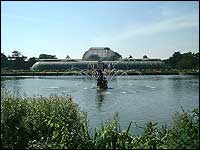
The Palm House is arguably the best known of all Kew's myriad attractions, and approaching it, it's impossible not to be impressed by the building; a magnificent, curvaceous body of glass. Walking into the Palm House itself is a strange experience. It's very humid, and the effect you experience is not dissimilar to that of stepping off a plane after landing in a hot and balmy country. As you breathe in the humid air through your nostrils, it feels warm and grassy, almost mint-like. This dose of plant-made oxygen is heady stuff indeed, and soon you'll notice a patina of sweat beginning to form on your face. However, this Researcher, in keeping with the spirit of eccentric British colonials abroad, refused to take off his jacket. It didn't quite seem proper, somehow.
The Palm House was completed in 1848 by engineer Richard Turner and renowned architect Decimus Burton. Amazingly, it contains over 16,000 panes of glass and houses 'mainly tropical woody plants representing the rain forests of America, Africa and Australasia'. The flora contained within is abundant and it's not difficult to imagine that you've landed somewhere in the Tropics. Firstly, there's a huge, thriving banana plant that certainly looks like a tree but which we are informed, is actually a giant herb. Then everywhere there is the passion flower, considered a good omen when first spotted by Spanish missionaries in South America in the 16th Century, that blushes bright red, painfully self-conscious of its lovely looks.
Coffee and Coconuts
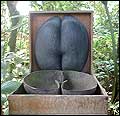
The African coffee plants serve to remind us of the origin of that which most of us drink every morning. Coffee berries each contain two seeds or 'beans' which are collected and roasted. These seeds contain the alkaloid caffeine, which stimulates the nervous system, and which is said to reduce fatigue. Top quality coffee is made from Coffea arabica while instant coffee is usually made from the poorer quality Coffea canephore.
After learning where your morning cuppa comes from, you can then get an amazing interactive experience with the sensitive plant (Mimosa pudica) which curls up its leaves in front of you, if you gently stroke them with your finger. Although, tragically, they are destined to remain unaware of the fact, the sensitive plant and the passion flower seem absolutely made for each other.

Next, there's the incredible Encephalartos altensteinii, the oldest pot plant in the world, having first been sown in 1775. Today, it looks like a huge reptilian Jack-in-the-box, sprung out from its hiding place, sprawled halfway across the room. Quite a magnificent sight.
Ambling through the Palm House you can see first-hand the fern-like Mexican cyad, threatened with extinction in its native Mexico, and the cocoa tree (Theobrora cacao) whose seeds were employed as currency in the Yucutan region right up to 1850. This Researcher has been paid peanuts in his time, but never seeds. Incredible. An impressive sight to behold indeed is the peach palm that grows up to 20m in height, but even this is eclipsed by the enormous palm tree that takes centre stage near the middle of the building. Its awesome uppermost branches strain to break through the glass roof, much like little fresh shoots sometimes push their way through tarmac, and we are reminded of the powerful lines of Dylan Thomas:
The force that through the green fuse drives the flower
Drives my green age; that blasts the roots of trees...
Next, the coconut trees, and my, they look so comical. It's easy to imagine gleeful monkeys hiding among the branches, hurling down coconuts at unsuspecting botanists, who rub their bespectacled heads, all earnest and perplexed. In keeping with this coconut theme, a little further along there is the coco-de-mer (Lodocea maldivica) whose seeds are the largest in the world, often found washed ashore along the islands of the Indian Ocean. And they are massive. Not unlike a gorilla's rump, the seed of the coco-de-mer is a mighty fine sight.
The Palm House is a fascinating place, feeling totally 'authentic'. And if you climb the 51 steps up the wrought iron staircase onto the indoor balcony, you can feel the heat rise and the breath quicken. Through the glass roof, brilliant sunshine pours in, hot on your face. For a moment, you're in a faraway country. Open your eyes, and then look down at the plethora of exotic greenery teeming all over the place. Remember, what's written here is only a tiny fraction of what you can find.
Walking Around
Kew Gardens is set in over 300 acres of land and aimlessly walking around it, on a summer's afternoon, is an absolute treat. It's fun to watch the other visitors too: individuals sat down studying their sandwiches, the pages of the book they brought with them to read flapping in the breeze; couples kissing quietly beneath the protective umbra of an old chestnut tree that's seen it all before; and kids playing a game of hide and seek, giggling, their faces pressed up against the expansive midriff of yet another kindly old tree. It's possible to lose hours just walking around Kew.
The Temperate House
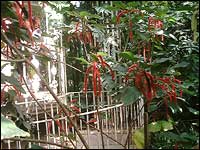
The approach to the Temperate House is lined either side by a host of Japanese cherry trees, and the closer you get to the building, you realise just how big it is. In fact, it is 180m in length and contains mainly 'tender, woody plants'. The building is split into four sections, all of which are divided geographically. Some of the places represented here are Japan, China, the Himalayas, New Guinea, Lord Howe Island, New Zealand, Australia, St Helena, South Africa and the Canary Islands. There are hundreds of plants to see, from the pretty-pink Rhododendron 'Piquante', to the Hibiscus insularis, with its many little gentle flowers, appearing somehow generous in an 'arms outstretched' sort of way.
As the name suggests, the Temperate House isn't as stuffy as the Palm House. Nevertheless, walking around you can still see the same wonderful range of plants, such as the Japanese banana (Musa basjooo) with its huge lop-eared leaves hanging down from up above and an interesting fellow called the honey palm (Jubaen chilensis). The honey palm is named after Juba, King of Numidia. It was originally raised from seeds collected in Chile, in 1846, and now fully mature, the trunk is among the thickest of all trunks in the plant kingdom. So thick set and large is this honey palm that it puts one in mind of the late, great actor Oliver Reed, and appropriately enough, the sap or palm syrup it produces can be fermented to make fine palm wine. And lots of it, too. Like the Palm House, the Temperate House is a magnificent glass structure stuffed to the rafters with the most diverse array of plants and trees from every corner of the world.
Evolution House
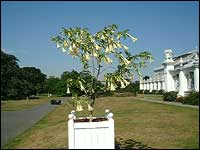
Evolution House is just next to Temperate House, and as you exit the one building to go into the other, you might just spot a lovely-looking flower called Brymansia X Candida 'Knightii'. Its flowers, hanging in the breeze, look for all the world like little swaying bells. It's impossible not to linger a little in front of them, waiting, just in case you catch downwind the faintest sound of tiny chiming music.
Outside the entrance to Evolution House, a plaque informs us that:
Today, the Earth is a green planet, covered with plants of all shapes and sizes. But until 3500 million years ago, there were no plants. What was the world like then? When did the first plants appear? How and why have plants changed?
Evolution House takes us back to the dawn of time and is a great place for kids. The information displayed on little plaques around the building are very informative, and so too are the leaflets you can pick up as you walk along. From bubbling replica mud swamps to yellow, sulphurous mini-mountains, Evolution House has a vaguely Jurassic Park feel to it. This is augmented by frequent, weird, swampy noises that, along with an occasional swirling mist, makes this small building well worth a visit. To reiterate; great for kids, simply because of its highly-educational content.
The Pagoda
At a height of 50m, the towering Pagoda at Kew is one of the Garden's most recognised landmarks. From a distance it looks uncannily like something we imagine from an ancient Chinese print brought to life. However, the closer you get to it, and indeed, when you get right up next to it, this sense of the East evaporates, revealing instead, a rather tired old building made up almost entirely of English red brick. The Pagoda was created by William Chambers for his patroness, Princess Augusta, who was the mother of King George III and the founder of Kew. Its design reflects the prevailing interest in all things Oriental at that time and, funnily enough, the Pagoda has no practical use whatsoever.
The Japanese Garden
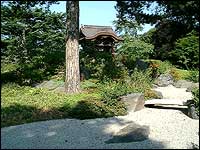
The Japanese Garden conveys upon the onlooker a much stronger sense of the East. The main visible structure is a gate-like building called the Chokushi mon - the 'Gateway of the Imperial Messenger'. This is made out of hinoki wood - Japanese cypress - and has a traditional copper roof. It is, in fact, a four-fifths replica of the original Karamon of Nishi Hongan-ji in Kyoto, Japan. There are many delicate-looking Japanese and Korean plants, that have been skillfully cultivated by Japanese garden experts, that are placed all around the surrounds of the building. Just behind the beautiful 'gateway', you can look down upon a traditional Japanese Zen garden with its neatly-raked dry stone gravel and rocks. Sitting down for a quiet moment on one of the benches in the garden, it's hard not to feel reflective, almost a little sad, even.
One especially neat thing about the garden is the haiku stone. This depicts a haiku poem, carved out in Japanese script, composed by the world-famous poet Kyoshi Takahama. In fact, Takahama actually composed the poem while sat in the very same spot the haiku stone is now. He wrote it on 2 May, 1936, and the stone was erected by his daughter, Hiruko, in 1979, as part of Kew's drive to help strengthen Anglo-Japanese ties.
Even sparrows
Freed from all fear of man
England in Spring
- Kyoshi Takahama
The Marianne North Gallery
Marianne North was an extraordinary Victorian lady who devoted the latter half of her life to extensive travelling and prolific painting. She was born in 1830 and was the daughter of Frederick North MP. Her paintings depict all the flowers and plants that she ever set eyes on; from Japan to the Himalayas, from Brazil to Jamaica. Her work is quite breathtaking and totally 'real' to the eye. The collection of 832 of her oil paintings that are displayed in the Marianne North Gallery is an important botanic document. Many of the plants she painted are endangered species, and some of them are now sadly extinct. The Gallery itself is small, but what is most striking about the place is the way that every inch of wall space is used, being totally covered with North's art. Peering in from the outside, this gives the impression that the Gallery's interior is like a precious, jewel-encrusted box. Marianne North donated all her botanical paintings to Kew in 1882, and entrance in to this little purpose-built gallery is free. It's well worth a visit.
Jo Self - Artist in Residence
Continuing the line of great women artists at Kew, Jo Self is now2 the artist in residence at the Gardens, a post she will hold for two years. Her work is bold and deceptively simple. The leaves and flowers she paints loom large and the colours in which she renders them are bright and wholly engaging. Talented and friendly with it, Jo Self will exhibit her work at Kew in spring 2001 and spring 2002. Half the proceeds of the work she sells she'll donate to Kew to help toward her botany projects. Find out more about Jo and her work at the Flowers East Gallery.
How to Get There
Kew Gardens is next to the River Thames and is about 10km south west of London. It can easily be reached using the London Underground and you can also get there by Silverlink overland trains. If you are travelling by car or coach you'll find that Kew Gardens is well signposted form all the major roads.

